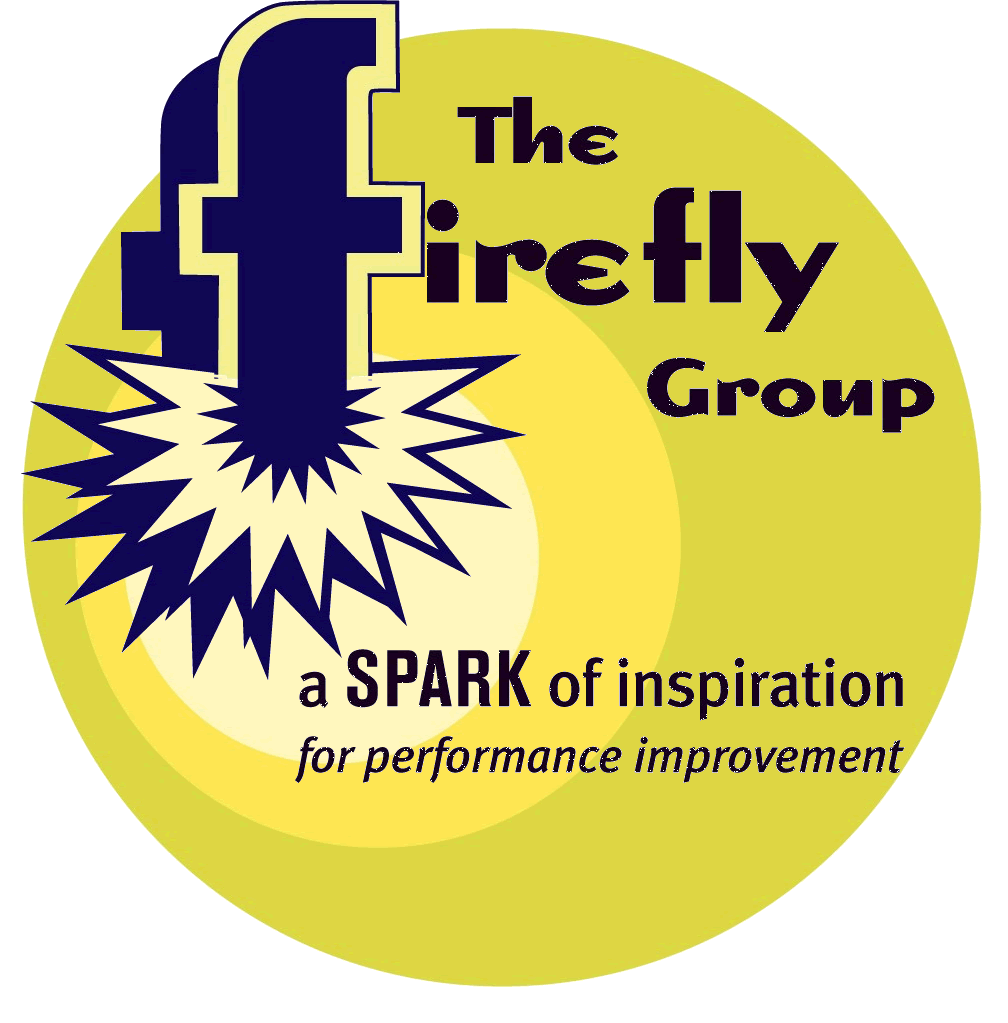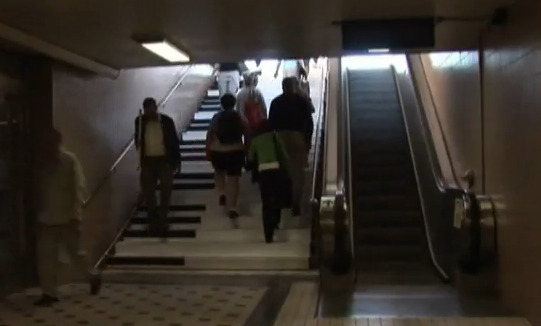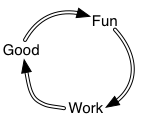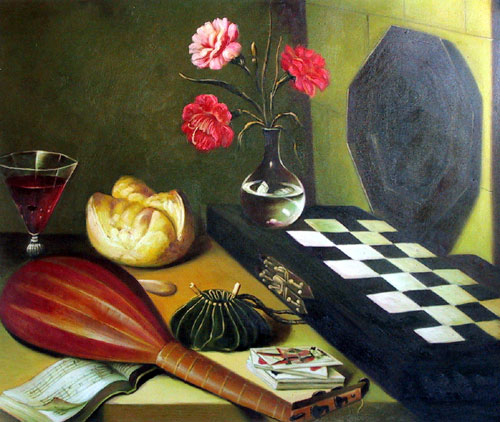


December 2009
In this Issue:
|
Say
It Quick |
Discoveries bits of serendipity to inspire and motivate |
Ideas fuel for your own continuous learning |
Activities tips and tricks you can try today |
| Imagine! | The Fun Theory | The Fun Cycle | Five Senses |
 What
makes something fun? Why aren't more things more fun for more people? And
what would happen if they were? These are just a few concepts we'll explore
beginning with this 99-Word story which suggests that fun can begin with one's
chosen state of mind.
What
makes something fun? Why aren't more things more fun for more people? And
what would happen if they were? These are just a few concepts we'll explore
beginning with this 99-Word story which suggests that fun can begin with one's
chosen state of mind.
Imagine!
Jeff was
definitely not an urbanite but he lived in an apartment above a busy Manhattan
street. The rush of urban living – especially the noise of traffic – began
to affect his sense of wellbeing. So, when a friend invited him to Martha’s
Vineyard, Jeff did not hesitate.
Two weeks surrounded by gulls and waves healed Jeff’s spirit with lasting impact. Back in New York, he still awoke with the sound of surf in his ears – even though it was really the traffic far below his window!
Imagination plus attitude equals playful medicine for everyday coping.
 Our
discovery this month is two-fold for we bring you both a person and a concept.
Not long ago, a friend shared a link to The Fun Theory which I found
to be a delightful concept. When I met Frank Medlar at a conference of the
North American Simulation and Gaming Association, I was taken with his playful
approach to learning. I knew he would have a wonderful perspective about The
Fun Theory to share. Here it is followed by more of his thoughts in our Ideas
column.
Our
discovery this month is two-fold for we bring you both a person and a concept.
Not long ago, a friend shared a link to The Fun Theory which I found
to be a delightful concept. When I met Frank Medlar at a conference of the
North American Simulation and Gaming Association, I was taken with his playful
approach to learning. I knew he would have a wonderful perspective about The
Fun Theory to share. Here it is followed by more of his thoughts in our Ideas
column.
The Fun Theory
by Frank Medlar
Throughout
history there have been times when a simple idea has created seismic change.
It happened 12,000 years ago when the first wooden plow led to the development
of agriculture and civilization. It happened when Darwin’s simple idea that
evolution worked though natural selection changed the life sciences. It is
happening now with the Internet creating a world without boundaries. World-changing
breakthroughs can come from simple ideas that take us beyond anything we have
been able to achieve.
We need more of that now, because the challenges we face not only threaten our economic viability, they put life on Earth at risk. To meet these challenges, we will have to achieve something that has proven very hard to do: change people’s behavior. Is there a simple way to change behavior for the better that we just haven’t latched onto yet?
Maybe there is a way, one so simple any good parent, teacher, or athletic coach could have told us about it. Mary Poppins claimed, “In any job that must be done, there is an element of fun. Find the fun and, snap, the job’s a game.”
That is the gist
of The Fun Theory, “…the thought that something as simple as
fun is the easiest way to change people’s behavior for the better. “ Volkswagen
of Sweden is running a contest called The Fun Theory, and they are
demonstrating that Fun works. 
One example: How to get people to exercise by walking up a stairway rather than taking the adjacent escalator? The simple solution: Turn the steps into piano keys. The result: People turn away from the escalator and skip, step, or dance their way up the stairs.
Recycling bottles and tossing trash can also become fun – and with much more effective results. Learn how by visiting The Fun Theory then what you think!
 The
Fun Cycle
The
Fun Cycle
by Frank Medlar
How could we miss something so simple? Perhaps because it’s been drilled into
us that Work and Fun are opposites. If you worked on Henry Ford’s production
line, laughing got you fired. It was no Fun factory.
But Work and Fun are not opposites; in fact, they go well together. Fran Kick, an author, educational consultant and professional speaker based in Ohio, talks about The Fun Cycle to demonstrate that when an activity is fun, we are more likely to work at it, which results in getting good at it, which makes the activity more fun, and so on. It is a 3-part cycle.
Fun, play, games, the stuff of childhood, are not childish after all. How different would our country be if Jefferson had written “the Pursuit of Fun” as one of our natural rights? We may get to find out. Fun can change behavior for the better. Soon we may approach challenges with the declaration, “I’ve got fun, and I know how to use it.” Just maybe, it will be like we discovered fire for the second time.
Frank Medlar is the President and C.T.O. (Chief Thinking Officer) of Applied Creative Thinking. Frank works with individuals and groups that want to align their strengths and make their weaknesses irrelevant. His signature program is Mind Over Information: Cognitive Strategies for Managing Information Overload.
Visit The Fun Theory and you'll quickly see what makes something fun: the opportunity to choose whether to participate, the ability to initiate an action, an engaging invitation, a playful sense of humor, a creative interface, and a clever audio system are just a few things that come quickly to mind.
But most of us don't have the mechanical, electrical, and carpentry skills to make a musical walkway or a talking garbage can. Nor would that address the many daily opportunities for using fun to inspire and motivate. With this in mind, I asked Linda Keller, Senior Director of Learning at Envision EMI, to think about what she has done to make her training more fun. Here's her low-tech solution.
Five Senses

by Linda Keller
When I
am in a training session, it can be fun to simply change my state of mind
- to relax for a few minutes, get my energy up, have a laugh or feel connected
with the people I work with. As a facilitator, you can tap into the power
of the physical senses to change people's state of mind and the energy in
the room.
Ask participants to name the 5 senses and list them for all to see: touch, hearing, smell, taste, and sight. Talk about how we use our senses to take in and respond to the world. On the one hand, they keep us safe and on the other, they can provide us with great pleasure. Allow participants three minutes to recall one thing for each of the 5 senses that they have experienced which makes them feel wonderful. (Example: The smell of bread baking.) Play music while people think.
Choose one of the senses and circle the group asking each person to share one example that is really wonderful for them. What is something you've seen? Next, what is a sound you've heard? What have you smelled? What have you tasted? What have you felt? Complete a loop for each sense.
By the end of these rounds, there will be a deep sense of pleasure and relaxation in the room. Everyone will be ready for the next item on the agenda.
Trainer Note: This same activity could be used to bring up energy. If you have been dealing with a heavy topic and need to change the channel, do the same exercise but ask people to identify something that delights or energizes them. (Example: The sound of the cards being shuffled before a poker game.)
Linda's activity is good for more than the training room. Try it at a meeting, at a dinner party, or on a long drive with restless youngsters. Make a note of what happens and be sure to the result!
Linda Keller is Senior Director of Learning for Envision EMI in Vienna, Virginia.
Read previous
issues. Click Archives!
To add or delete your name to our mailing list, email
with a short note in the subject line.
We want this newsletter to be practical, succinct, and thoughtful. If you have suggestions about how we can meet these criteria, please let us know! Send us an with your thoughts and ideas.
Home
| Services
| Products
| Mission
| Ideas |
The Group
| The Buzz
(c)
2005 The Firefly Group